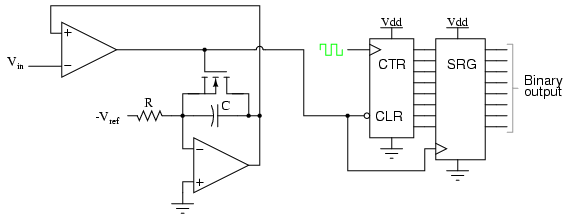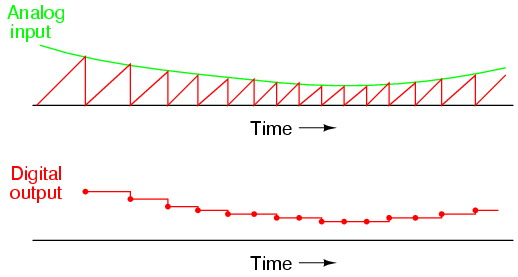So far, we've only been able to escape the sheer
volume of components in the flash converter by using a DAC as part of our
ADC circuitry. However, this is not our only option. It is possible to avoid
using a DAC if we substitute an analog ramping circuit and a digital counter
with precise timing.
The is the basic idea behind the so-called single-slope, or
integrating ADC. Instead of using a DAC with a ramped output, we use an
op-amp circuit called an integrator to generate a sawtooth waveform
which is then compared against the analog input by a comparator. The time it
takes for the sawtooth waveform to exceed the input signal voltage level is
measured by means of a digital counter clocked with a precise-frequency
square wave (usually from a crystal oscillator). The basic schematic diagram
is shown here:

The IGFET capacitor-discharging transistor scheme shown here is a bit
oversimplified. In reality, a latching circuit timed with the clock signal
would most likely have to be connected to the IGFET gate to ensure full
discharge of the capacitor when the comparator's output goes high. The basic
idea, however, is evident in this diagram. When the comparator output is low
(input voltage greater than integrator output), the integrator is allowed to
charge the capacitor in a linear fashion. Meanwhile, the counter is counting
up at a rate fixed by the precision clock frequency. The time it takes for
the capacitor to charge up to the same voltage level as the input depends on
the input signal level and the combination of -Vref, R, and C.
When the capacitor reaches that voltage level, the comparator output goes
high, loading the counter's output into the shift register for a final
output. The IGFET is triggered "on" by the comparator's high output,
discharging the capacitor back to zero volts. When the integrator output
voltage falls to zero, the comparator output switches back to a low state,
clearing the counter and enabling the integrator to ramp up voltage again.
This ADC circuit behaves very much like the digital ramp ADC, except that
the comparator reference voltage is a smooth sawtooth waveform rather than a
"stairstep:"

The single-slope ADC suffers all the disadvantages of the digital ramp
ADC, with the added drawback of calibration drift. The accurate
correspondence of this ADC's output with its input is dependent on the
voltage slope of the integrator being matched to the counting rate of the
counter (the clock frequency). With the digital ramp ADC, the clock
frequency had no effect on conversion accuracy, only on update time. In this
circuit, since the rate of integration and the rate of count are independent
of each other, variation between the two is inevitable as it ages, and will
result in a loss of accuracy. The only good thing to say about this circuit
is that it avoids the use of a DAC, which reduces circuit complexity.
An answer to this calibration drift dilemma is found in a design
variation called the dual-slope converter. In the dual-slope
converter, an integrator circuit is driven positive and negative in
alternating cycles to ramp down and then up, rather than being reset to 0
volts at the end of every cycle. In one direction of ramping, the integrator
is driven by the positive analog input signal (producing a negative,
variable rate of output voltage change, or output slope) for a fixed
amount of time, as measured by a counter with a precision frequency clock.
Then, in the other direction, with a fixed reference voltage (producing a
fixed rate of output voltage change) with time measured by the same counter.
The counter stops counting when the integrator's output reaches the same
voltage as it was when it started the fixed-time portion of the cycle. The
amount of time it takes for the integrator's capacitor to discharge back to
its original output voltage, as measured by the magnitude accrued by the
counter, becomes the digital output of the ADC circuit.
The dual-slope method can be thought of analogously in terms of a rotary
spring such as that used in a mechanical clock mechanism. Imagine we were
building a mechanism to measure the rotary speed of a shaft. Thus, shaft
speed is our "input signal" to be measured by this device. The measurement
cycle begins with the spring in a relaxed state. The spring is then turned,
or "wound up," by the rotating shaft (input signal) for a fixed amount of
time. This places the spring in a certain amount of tension proportional to
the shaft speed: a greater shaft speed corresponds to a faster rate of
winding. and a greater amount of spring tension accumulated over that period
of time. After that, the spring is uncoupled from the shaft and allowed to
unwind at a fixed rate, the time for it to unwind back to a relaxed state
measured by a timer device. The amount of time it takes for the
spring to unwind at that fixed rate will be directly proportional to the
speed at which it was wound (input signal magnitude) during the
fixed-time portion of the cycle.
This technique of analog-to-digital conversion escapes the calibration
drift problem of the single-slope ADC because both the integrator's
integration coefficient (or "gain") and the counter's rate of speed are in
effect during the entire "winding" and "unwinding" cycle portions. If the
counter's clock speed were to suddenly increase, this would shorten the
fixed time period where the integrator "winds up" (resulting in a lesser
voltage accumulated by the integrator), but it would also mean that it would
count faster during the period of time when the integrator was allowed to
"unwind" at a fixed rate. The proportion that the counter is counting faster
will be the same proportion as the integrator's accumulated voltage is
diminished from before the clock speed change. Thus, the clock speed error
would cancel itself out and the digital output would be exactly what it
should be.
Another important advantage of this method is that the input signal
becomes averaged as it drives the integrator during the fixed-time portion
of the cycle. Any changes in the analog signal during that period of time
have a cumulative effect on the digital output at the end of that cycle.
Other ADC strategies merely "capture" the analog signal level at a single
point in time every cycle. If the analog signal is "noisy" (contains
significant levels of spurious voltage spikes/dips), one of the other ADC
converter technologies may occasionally convert a spike or dip because it
captures the signal repeatedly at a single point in time. A dual-slope ADC,
on the other hand, averages together all the spikes and dips within the
integration period, thus providing an output with greater noise immunity.
Dual-slope ADCs are used in applications demanding high accuracy. |